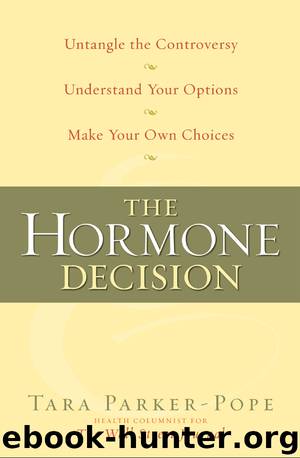The Hormone Decision by Tara Parker-Pope

Author:Tara Parker-Pope
Language: eng
Format: epub
Publisher: Potter/Ten Speed/Harmony/Rodale
Published: 2014-05-14T04:00:00+00:00
HORMONES AND STROKE RISK
Stroke is a form of cardiovascular disease that affects the arteries leading to and existing within the brain. Strokes can be caused either by a clot obstructing the flow of blood to the brain or by a blood vessel rupturing and preventing blood from reaching the brain.
While most of the early data on hormone use pointed to a protective benefit for cardiovascular disease, the evidence is more mixed in terms of stroke. Some studies have reported no change in risk with hormone use, others have shown a higher risk of stroke among hormone users, and one even suggested a reduction in risk.29 Some of the studies found no overall increase in risk over time but a higher risk in the first 6 months of use.
As for the WHI, it showed that starting hormones late in life raises the risk of stroke. This likely occurs because hormones are known to increase the risk of blood clots, and blood clots can trigger both heart attack and what’s known as ischemic stroke. The WHI found that women who took estrogen and progestin had a 44 percent higher risk of ischemic stroke,30 while women who used estrogen by itself had a 55 percent higher risk.31
It remains an open question whether women who start using hormones at the time of menopause to treat symptoms face the same increase in risk. As we discussed in Chapter 4, WHI researchers have reanalyzed their data and determined that hormone users who were within 10 years of menopause had a lower risk of heart problems than nonusers. The data are less clear for stroke. There were so few cases of stroke in younger women that the data don’t have statistical meaning. However, the pattern of higher stroke risk was similar across all age groups.
Don’t be alarmed by all the scary-sounding percentages. After all, birth control pills also increase a woman’s risk of stroke. For most women, it was a risk they were willing to take during their reproductive years because the likelihood of having a stroke at a young age is so low to start with. What matters most to women considering hormones for the treatment of menopausal symptoms is their absolute risk of stroke. For women under age 65, the risk is extraordinarily low; so even with a marked increase in risk due to hormone use, the overall chance of having a stroke remains very low. A healthy, nonsmoking 55-year-old woman has a 1.1 percent chance of suffering a stroke in the next 10 years. The annual incidence of stroke among women ages 45 to 54 is 0.1 per 1,000 women.32
Keep in mind that these numbers are for a healthy woman. If you smoke or have high blood pressure or diabetes, you’re at higher risk for stroke to begin with. Your 10-year risk is 6.3 percent, so any increase in that risk due to hormone use becomes far more meaningful.
To get a sense of your personal risk of stroke and how you compare with other people your age, an excellent resource is the Harvard School of Public Health Web site, www.
Download
This site does not store any files on its server. We only index and link to content provided by other sites. Please contact the content providers to delete copyright contents if any and email us, we'll remove relevant links or contents immediately.
Name Book, The: Over 10,000 Names--Their Meanings, Origins, and Spiritual Significance by Astoria Dorothy(2841)
Tone Your Tummy Type by Denise Austin(2638)
The Expectant Father by Armin A. Brott & Jennifer Ash(2172)
The Women's Health Fitness Fix by Jen Ator(2136)
The Coregasm Workout by Debby Herbenick(2131)
Expecting Better by Emily Oster(2086)
The Ultimate Guide to Anal Sex for Women by Tristan Taormino(2074)
She-ology by Sherry A. Ross MD(1979)
The Hite Report on Shere Hite by Shere Hite(1961)
Woman: An Intimate Geography by Natalie Angier(1843)
8 Steps to Reverse Your PCOS by Fiona McCulloch(1831)
Birth by Tina Cassidy(1804)
The Female Brain by M.D. Louann Brizendine(1795)
101 Get-Lean Workouts and Strategies by Muscle & Fitness(1723)
Women & the Weight Loss Tamasha by Diwekar Rujuta(1722)
50 Ways to Soothe Yourself Without Food by Susan Albers(1675)
The Big Booty Blueprint: Your Guide To A Bigger Butt In Less Than 12 Weeks by Bella Rahbek & Brandon Carter(1568)
Unleash the Power of the Female Brain: Supercharging Yours for Better Health, Energy, Mood, Focus, and Sex by Daniel G. Amen M.D(1494)
The overachievers by Robbins Alexandra(1492)
